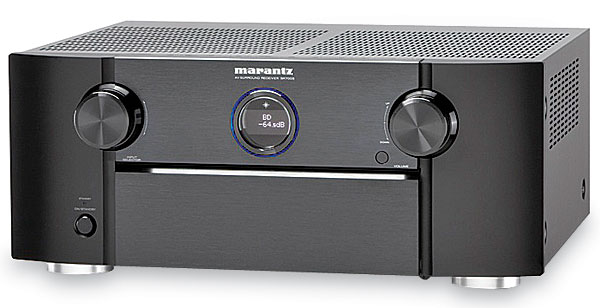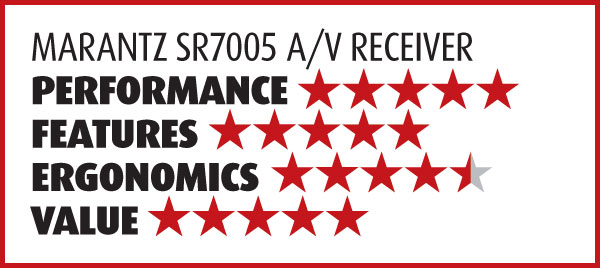Marantz SR7005 A/V Receiver Page 3
Bold as Love
When an A/V receiver as good as this slides into my rack’s guest berth, my listening choices get bolder. I wanted something to play loud and picked Who’s Next on vinyl. As with all of my music demos, Audyssey Dynamic EQ and Dynamic Volume were turned off (entirely) and MultEQ XT on (most of the time). I cruised along at 85 decibels according to my SPL meter, the reference level defined by the Society of Motion Picture and Television Engineers (SMPTE) and promulgated by Dolby and THX. This may be normal for some listeners but it’s on the loud side for me. Keith Moon’s drums were as explosive as I dared to hope, crashing on the shore like a series of tall, percussive waves. What surprised me was the tunefulness of John Entwistle’s bass. It wasn’t any higher in the mix than it should have been,
but it was endlessly powerful,
and the precision of its pitches, combined with Entwistle’s melodic prowess, reminded me that he had practically turned bass into a lead instrument. I loved
the old-fashioned sound of Pete Townshend’s guitars, both the valve-amped electric and the close-miked acoustic, sculpted with the analog tools of their
day. The system’s resolution highlighted the various forms
of processing and doubletracking that massaged the vocals—although without diminishing
the emotional catharsis of Roger Daltrey’s memorable scream
in “Won’t Get Fooled Again.”
This was the best-ever Who’s
Next presentation in my listening life.

I was still feeling bold, so I chose an album that’s always puzzled me to see if I’d like it better. James Blood Ulmer’s Tales of Captain Black features a quartet consisting of the electric guitarist, his early mentor Ornette Coleman on alto sax, Coleman’s son Denardo on drums, and Jamaaladeen Tacuma on electric bass. I’d last heard it shortly after it was released in 1979 and therefore had never heard it in surround via the Dolby Pro Logic II Music mode, with room correction, through a tubed phono stage—or through the ears of a more experienced listener. Finally I “got” this album: The surging melodic fragments arising like jets of hot steam from Ulmer and Ornette, Denardo’s responsive drumming, and most of all, the tireless melodic inventiveness of Tacuma, yet another lead bassist. Here was another heartening demonstration of how technology can transform our relationship with music and bring us closer to it, right against its beating heart.
The music industry, probably in its death throes, has been releasing massive CD box sets of classical music in slim paper wallets at a low per-disc cost. I was glad to have acquired Glenn Gould: The Complete Original Jacket Collection before it almost instantly went out of print. I was on my second journey through it as I was writing this review. Not quite at random, I chose disc 46 (out of 80): The Mozart Piano Sonatas Vol. 4, circa 1973, with sonatas 11 and 15 and the Fantasia in D Minor. My boyhood experiences with Gould led me to expect a light, slightly opaque sound, with overtones cut short by his clipped phrasing and minimal pedaling. Once again, for the third consecutive time, this system (and probably a fresh CD remastering) helped me hear it in a new way. The inner detail and sonority that I’d always assumed were missing suddenly appeared, subtle but definitely present. Dynamic gradations multiplied, shedding fresh light on Gould’s tendency to recompose well-known works. Close-miking and DPLII resulted in an in-the-piano sound, which is probably closer than Gould and his technical help intended. But I quickly got used to this, came to prefer it, and ultimately was reminded that Gould’s soundscapes were rooted more in the studio than in the concert hall—so this up-close, hyper-revealing sound was entirely in keeping with his aspirations. For the third consecutive time, the Marantz AVR, its Audyssey enhancements, and my Paradigm speakers knocked me flat.
The Marantz SR7005 is the kind of A/V receiver that wins applause. The company has reconciled its distinguished twochannel heritage with the latest features that home theater buffs expect in an AVR that sells well into the four-figure range. In the time I spent with this model, not for a moment did it ever lack the performance or the listening options I expect in a pricey AVR. In fact, considering all the goodies it provides, and at this level of sonic accomplishment, this A/V receiver may be underpriced. Well done.































































